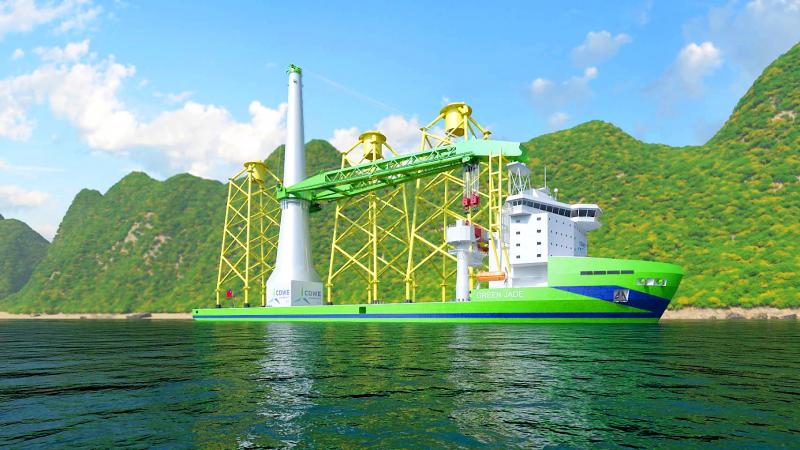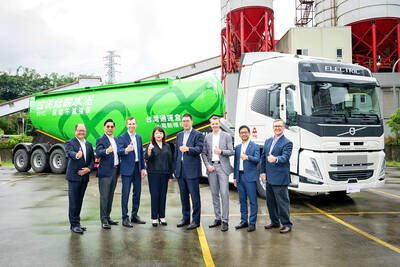CSBC-DEME Wind Engineering Co (CDWE, 台船環海) expects its NT$7.5 billion (US$253.44 million) crane vessel investment to pay off in 10 years, as it meets rising demand for large-scale offshore wind farms in Asia, CDWE chairman Robert Tseng (曾國正) said on Friday last week.
The company — a joint venture between CSBC Corp, Taiwan (台灣國際造船), which owns 50.0001 percent of the company, and Belgium-based Dredging, Environmental and Marine Engineering NV (DEME) — on June 30 commissioned CSBC to build the Green Jade, whose construction is the most expensive among the commercial vessels CSBC has built, said Tseng, who is also president of CSBC.
For example, CSBC built five 14,000 twenty-foot-equivalent unit container vessels for Yang Ming Marine Transport Corp (陽明海運), at an average building price of less than NT$3 billion, Tseng said.

Photo courtesy of CSBC Corp, Taiwan
“It is a huge investment, but we expect to recover the cost in 10 years after the Green Jade is launched in 2023,” he said.
From 2023 to 2025, the Green Jade would support the nation’s two offshore wind farms — the Hai Long (海龍) 2 and 3 projects, with a combined capacity of 1.044 gigawatts, and the Chong Neng (中能) project with a capacity of 300 megawatts, Tseng said.
CDWE would use the vessel to transport and install the wind turbine towers’ foundation system, he said.
The company last year signed preferred supplier agreements with Hai Long’s developers Northland Power Inc, Yushan Energy Pte (玉山能源) and Misty & Co Ltd, as well as Chong Neng’s developers China Steel Corp (中鋼) and Copenhagen Infrastructure Partners K/S, he said.
The 216.5m vessel is to be equipped with a 4,000-tonne crane as well as a class-3 dynamite positioning system. The crane would be able to lift and accurately position heavy components, CSBC said.
The vessel has a cargo area of 8,200m2, or 1.3 times that of a standard football field, and could carry equipment such as a hydraulic hammer to drive huge piles into the seabed, the company said.
High efficiency in construction would be one of the Green Jade’s advantages, while it is also capable of installing mega structures at great depths, Tseng said.
That would give CDWE an advantage in seeking new clients, he said.
The Ministry of Economic Affairs is formulating the zoning policy for offshore wind farms for 10 years from 2026 to 2035, and offshore wind farm developers are seeking to set up farms farther from the coast, so construction would be in deeper water, he said.
CDWE has been talking with a number of wind farm developers regarding their projects after 2026, he added.
Given that there are only six months that are suitable for marine construction in the Taiwan Strait, CDWE intends to cooperate with developers in foreign countries to use the Green Jade to work on other offshore wind farms for additional revenue, Tseng said.
“As DEME is an international enterprise with clients around the world, CDWE can deploy its network to find foreign clients,” Tseng said.
CSBC is still working on the detailed design of the Green Jade, but plans to begin construction by the end of this year, he said.
CDWE is to pay CSBC 30 percent, or NT$2.25 billion, as a down payment for the vessel, meaning that the firm, with NT$350 million in capital, would need to raise NT$1.8 billion within the next two months, he said.

Taiwan Transport and Storage Corp (TTS, 台灣通運倉儲) yesterday unveiled its first electric tractor unit — manufactured by Volvo Trucks — in a ceremony in Taipei, and said the unit would soon be used to transport cement produced by Taiwan Cement Corp (TCC, 台灣水泥). Both TTS and TCC belong to TCC International Holdings Ltd (台泥國際集團). With the electric tractor unit, the Taipei-based cement firm would become the first in Taiwan to use electric vehicles to transport construction materials. TTS chairman Koo Kung-yi (辜公怡), Volvo Trucks vice president of sales and marketing Johan Selven, TCC president Roman Cheng (程耀輝) and Taikoo Motors Group

Among the rows of vibrators, rubber torsos and leather harnesses at a Chinese sex toys exhibition in Shanghai this weekend, the beginnings of an artificial intelligence (AI)-driven shift in the industry quietly pulsed. China manufactures about 70 percent of the world’s sex toys, most of it the “hardware” on display at the fair — whether that be technicolor tentacled dildos or hyper-realistic personalized silicone dolls. Yet smart toys have been rising in popularity for some time. Many major European and US brands already offer tech-enhanced products that can enable long-distance love, monitor well-being and even bring people one step closer to

RECORD-BREAKING: TSMC’s net profit last quarter beat market expectations by expanding 8.9% and it was the best first-quarter profit in the chipmaker’s history Taiwan Semiconductor Manufacturing Co (TSMC, 台積電), which counts Nvidia Corp as a key customer, yesterday said that artificial intelligence (AI) server chip revenue is set to more than double this year from last year amid rising demand. The chipmaker expects the growth momentum to continue in the next five years with an annual compound growth rate of 50 percent, TSMC chief executive officer C.C. Wei (魏哲家) told investors yesterday. By 2028, AI chips’ contribution to revenue would climb to about 20 percent from a percentage in the low teens, Wei said. “Almost all the AI innovators are working with TSMC to address the

Malaysia’s leader yesterday announced plans to build a massive semiconductor design park, aiming to boost the Southeast Asian nation’s role in the global chip industry. A prominent player in the semiconductor industry for decades, Malaysia accounts for an estimated 13 percent of global back-end manufacturing, according to German tech giant Bosch. Now it wants to go beyond production and emerge as a chip design powerhouse too, Malaysian Prime Minister Anwar Ibrahim said. “I am pleased to announce the largest IC (integrated circuit) Design Park in Southeast Asia, that will house world-class anchor tenants and collaborate with global companies such as Arm [Holdings PLC],”